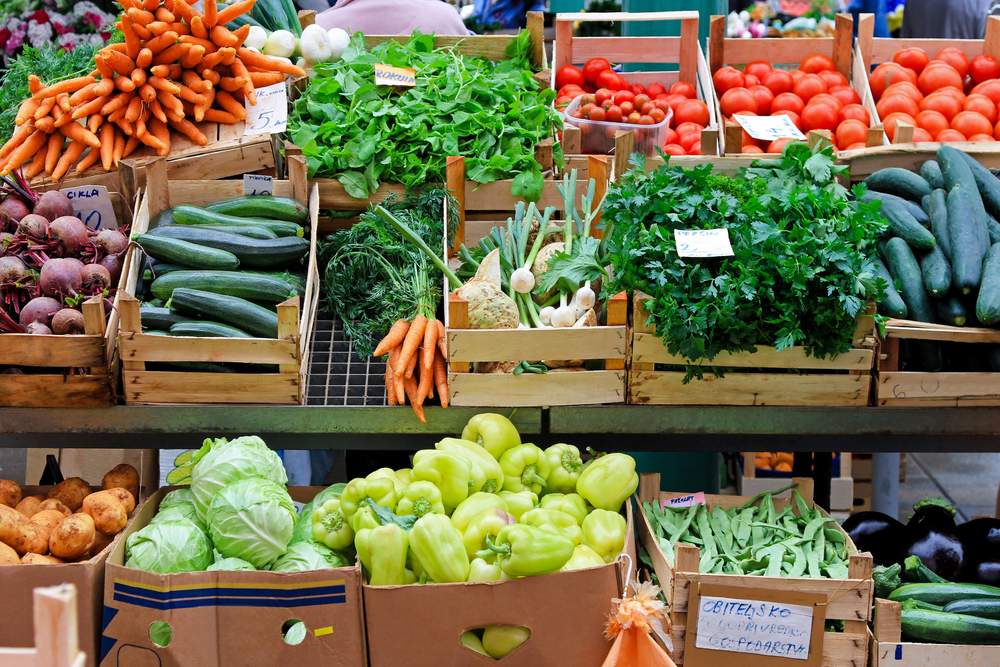When someone suggests reducing your food budget, your mind might immediately jump to some dark places. Images of ramen noodle bowls spinning in the microwave or the smell of a bologna sandwich might be enough to make you leery of exploring how to save money on food.
According to the US Department of Agriculture, the average cost of food at home in May 2019 was between $550-$650 for a family of 4 with young children on a “thrifty plan.” A “liberal plan” ranged from between $1100 to just shy of $1300 on average. Additionally, studies found that in 2017, the average American adult spent between $2,000 and $4,500 eating out.
If you want to figure out how to save money on food, you aren’t alone. What is holding you back? If it is the idea that spending less on food means that you will be eating terribly, we have good news. We have 22 ideas on how to save money on food without sacrificing taste.
Table of Contents
Save money at the grocery store
1. Switch grocery stores

When is the last time that you shopped around to compare prices? If you have been going to the same grocery store for years, you might be spending way more than you could be by switching to a different grocery store. The internet makes this easier, as you can even compare prices at some grocers from the comfort of your own home.
2. Use coupons
You don’t have to hunt down the Sunday newspaper and spend an hour cutting out physical coupons any longer to take advantage of savings. Most grocery stores have the option to set up an online account and digitally download coupons to your shopper’s card. Then, you just have to swipe your shopper’s card in the store to redeem your coupons.
3. Meal plan
Efficient meal planning is helpful for many reasons. It helps you avoid the age-old “what on earth am I going to have for dinner” question at 4:30 every afternoon. You are able to go to the grocery store once, instead of having to go multiple times throughout the week (which, by the way, will likely lead to spending more money due to more opportunities for impulse food buys) and you can limit food waste by planning meals with overlapping ingredients.
4. Meal prep
Meal planning means you have great intentions, but following through on those intentions is easier said than done some weeks. When you do your meal planning and grocery shopping for the week, block out some additional time to prep food for the week. Chop veggies, brown meat, cook rice, whatever you can do to make it easier to follow through on your meal plan throughout the week.

Meal prepping is a great way to make eating lunch from home easier than grabbing something at a restaurant. Decide on what you want for lunches for the week, then cook it on Sunday. Separate it into five individual containers, and all you have to do each day is grab a container from the fridge.
5. Online grocery shopping

This one might seem counterproductive, as online grocery ordering often has a fee connected to it. However, if you are prone to impulse buys at the grocery store, the fee can be worth it to avoid that temptation. Grocery delivery services are often significantly more expensive, so consider a service offered by the grocer itself that allows you to swing by and pick up the groceries you have selected online.
If you are honest with yourself and know that you typically impulsively spend more than the online ordering fee when you are at the store, consider using the service instead. Not only will you save some time by not having to actually go grocery shopping, but you are also saving money by avoiding those impulse snack buys.
Looking for a grocery delivery service?
 Get $20 OFF Your First Order! Try Peapod HERE>
Get $20 OFF Your First Order! Try Peapod HERE>6. Save with grocery apps
Apps like Ibotta, Checkout 51, Saving Star, Shopkick, Fetch Rewards, Favado, and more are designed to help you save money at the grocery store. While each works differently, grocery apps can lower the price of some items at the time of purchase, help you compare prices, or provide rebates to get money back after you have purchased a specific item.
See: The Best Apps For Saving Money (2019) >
7. Convenience costs more
Smaller packages of food might be easier to grab on the go, but you will be paying significantly more for them. By switching from convenience-oriented packaging to spending a little extra time repackaging bulk items into single-serve portions, you can save money while literally eating the exact same things.
Invest in a large, much cheaper tub of yogurt and portion it out into individual-sized food storage containers instead of spending more on individually packaged yogurt cups. Buy a large bag of pretzels or chips and divvy it out into small bags instead of buying snack-sized bags. Peel and cut full-sized carrots down into smaller pieces instead of buying more expensive baby carrots.
8. Buy food that is in season

Produce prices can fluctuate significantly, depending on what is in season. If you eat a lot of fruits or vegetables, pay attention to what is ripe and readily available. Often, there will be much better prices on produce that is in season, plus it will taste much better than during the off-season.
9. Make your own spice mixes
Take a walk down the spice aisle, and you will find bottles of pre-mixed spices for a variety of different meats and tastes. All it takes, however, is a quick look at the label to discover that you very well may already have all the ingredients in your spice rack at home.
Taco seasoning is a prime example. Most of the spices and herbs in taco seasoning mixes are pretty standardly found in most kitchens. Make your own taco seasoning mix out of the spices you already have on hand instead of spending extra to buy it premixed. It even tastes a little better when you mix it on your own, and you can adjust flavors slightly to your preferences.
10. Skip meat once a week
If your family eats a lot of meat, the expense can really add up. Cutting out meat even one day a week can make a noticeable difference in your grocery spending. If you get a little creative and don’t draw attention to what you are doing, your family might not even really notice that your meal was meatless!
If cutting meat out entirely for a meal isn’t an option, reduce the amount of meat you serve. If you would normally make 1 pound of ground beef for taco night, make ½ a pound instead and add lentils or black beans.
11. Avoid the name brands
Name brands are able to charge more money because they have earned your trust as a household name. When you are trying to get serious about reducing your food budget, however, switching to an off-brand for certain groceries is an easy change to make.
You will likely be surprised that you don’t even notice a difference between most name brand and off-brand options, and you may even wonder why you didn’t make the switch sooner!
Save money when eating out
12. Just water, please

An easy way to save money at restaurants is to skip ordering a drink. Water is free, and with a soda boasting a price tag of around $3 and alcohol costing, even more, skipping a drink can be a great way to save money while eating out.
If you are celebrating, or just want to wind down with a drink, stop by the liquor store on your way home. You can often get an entire bottle of wine or a six-pack of beer for the price of one serving at a restaurant.
13. Split an entrée
If you’re eating out at a restaurant with notoriously large portions, consider splitting it with someone. Add an extra side of fries or a small salad if you want, and splitting the cost will be a significant savings. Not to mention, no leftovers that will just sit in your fridge until you are wondering what that smell is three weeks later.
14. Eat out less often

Grabbing lunch at a fast-food drive-thru may not seem like a huge investment, but if you are doing it a few times a week that $7 or $8 starts adding up. Commit to eating out less often so you can maybe splurge on a little nicer meal once a week and still end up able to lower your budget.
15. Go pick it up
Delivery fees are expensive, not to mention the fact that you should tip your driver as well. Go pick your order up yourself if you don’t have any sort of free delivery promo code. By skipping the delivery option, you can save an average of five bucks each time you order food. Sure, food delivery is convenient. If saving money is your goal, however, it is absolutely worth it to be your own delivery person.
16. Look for restaurant coupons

Coupons aren’t just for the grocery store. Many restaurants will send their email lists regular coupons, and it’s relatively easy to find coupons online with a quick Google search. Sign up for your favorite restaurants’ email lists and pay attention to their emails to check for coupons that will save you money on a meal out.
17. Earn those loyalty points
Many casual restaurants offer loyalty programs that reward you for making regular purchases. These rewards usually come in the form of free food, which is an excellent way to save money on your food budget! If your favorite restaurants offer a loyalty program, take a few minutes to sign up and be sure you are taking advantage of their rewards.
18. Know the specials
If your favorite restaurant has your favorite dish on special every Tuesday night, that is the night you should be going. If you know you can get a dish for cheaper one night, spending more money on the same dish any other night is somewhat frivolous. Know the specials schedule at your favorite restaurants, and use it to your budget’s advantage.
19. Don’t get caught off guard

If you are interested in trying a new restaurant, do a little research first. Look up the menu, and any special offers, online so you aren’t caught off guard by the prices when you arrive. It would be extremely embarrassing to get seated and settled in, only to discover you can’t really afford to eat there.
20. Go out for lunch instead of dinner
Lunch menus are often cheaper than dinner menus. If you have some flexibility in your schedule, splurge on a meal out at lunchtime to save a little money. If your schedule doesn’t allow it, hit up the happy hour food menu instead of the full dinner menu. While you may have fewer options, you can eat well for less money.
21. Make coffee at home

While coffee isn’t technically a food, it is often included under the food budget. Making your coffee at home instead of hitting up a coffee shop each morning (or even a few mornings a week) can save you a noticeable amount of money. Plus, Making coffee at home has never been easier, thanks to products like the KEURIG.
Get in the habit of making coffee at home regularly, and treating yourself at a coffee shop only when you have a gift card. If your coffee of choice can’t be made at home without special equipment, at least skip the breakfast options. Most pastries can be made at home for much cheaper, and fresh fruit and yogurt parfaits are often significantly marked up.
22. Earn cashback
Regardless of whether you are at the grocery store or grabbing something to eat at a restaurant, take advantage of a rewards card. You could earn cashback on your food purchases, which is literally money back in your wallet. If you do a lot of traveling, you could also be earning points for airline or hotel redemptions with each purchase.
You may like: The Best Apps For Saving Money (2019)






